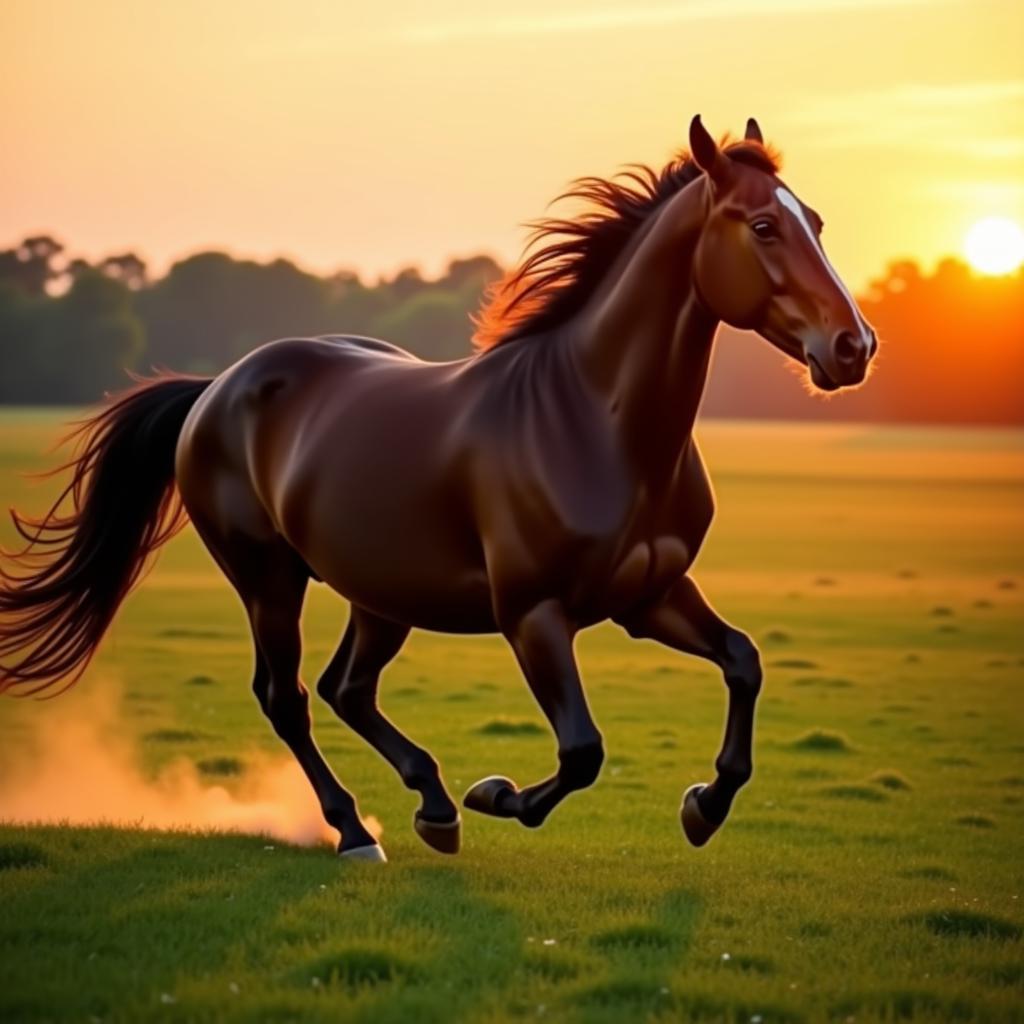The captivating Chocolate Horse Color, a rich, decadent shade of brown, often evokes images of elegant steeds galloping across open fields. But what exactly creates this beautiful coat color? This article delves into the genetics, variations, and care considerations surrounding chocolate horses, providing a comprehensive guide for horse enthusiasts.
The “chocolate” color in horses isn’t a single, uniform shade. It encompasses a spectrum of browns, ranging from milk chocolate light to a deep, dark chocolate hue. Understanding the underlying genetics is key to appreciating the nuances of this stunning coat color. The primary gene responsible for the chocolate horse color is the Agouti gene. Variations within this gene, coupled with other modifying genes, result in the diverse array of brown shades we see.  A chocolate horse running in a field
A chocolate horse running in a field
Decoding the Genetics of the Chocolate Horse Color
The Agouti gene controls the distribution of black pigment (eumelanin) in the horse’s coat. In chocolate horses, this gene restricts the black pigment primarily to the points—the mane, tail, and lower legs—while the body coat is a shade of brown. This is similar to the bay color, but with a significant reduction in black pigment, resulting in the characteristic brown shades.
Variations Within the Chocolate Spectrum
Several factors contribute to the variations within the chocolate horse color. Modifying genes can influence the intensity and shade of brown, creating hues like liver chestnut, dark chocolate, and milk chocolate. The presence of other genes, such as the cream gene, can further lighten the coat, leading to shades like chocolate palomino or chocolate buckskin. silver dapple black horse
Caring for Your Chocolate Horse
While the chocolate horse color doesn’t require any specific care regimen, maintaining a healthy coat is crucial for any horse. Regular grooming, a balanced diet, and protection from sun exposure can help preserve the richness and vibrancy of the chocolate coat.
Protecting Your Chocolate Horse from the Sun
Chocolate horses, especially those with lighter shades, can be more susceptible to sun bleaching. Providing adequate shade, using horse-specific sunscreen, and ensuring proper hydration are essential for protecting their coat from the damaging effects of the sun. What are the best ways to protect a chocolate horse from the sun? Provide ample shade, utilize equine sunscreen, and maintain hydration. horse saddles colors
Identifying a True Chocolate Horse
Sometimes, other coat colors can be mistaken for chocolate. A key distinguishing feature of a true chocolate horse is the absence of any true black hairs in the body coat. While the points may be black, the body coat should consist of various shades of brown.
Distinguishing Chocolate from Other Brown Shades
Liver chestnut, for instance, can appear similar to dark chocolate, but often has a reddish tinge. Sooty palomino horses can also exhibit brown shades, but typically have lighter manes and tails. Careful observation of the coat color and points can help differentiate these shades from the true chocolate horse color. dark horse names
Dr. Amelia Hart, an equine geneticist, emphasizes, “Understanding the Agouti gene is fundamental to comprehending the myriad of brown coat colors in horses. The chocolate horse color, with its rich variations, is a testament to the complexity of equine genetics.”
Equine nutritionist, David Miller, adds, “A balanced diet rich in essential nutrients plays a vital role in maintaining a healthy and vibrant coat, regardless of the horse’s color. For chocolate horses, this is particularly important for preserving the richness of their brown hues.” chocolate brown horse sooty palomino horse
Conclusion
The chocolate horse color, with its captivating shades and genetic intricacies, is a fascinating subject for horse lovers. By understanding the genetics, variations, and care considerations associated with this beautiful coat color, we can better appreciate the unique beauty of chocolate horses.
For assistance, contact us at Phone: 0772127271, Email: [email protected], or visit us at QGM2+WX2, Vị Trung, Vị Thuỷ, Hậu Giang, Việt Nam. Our customer service team is available 24/7.